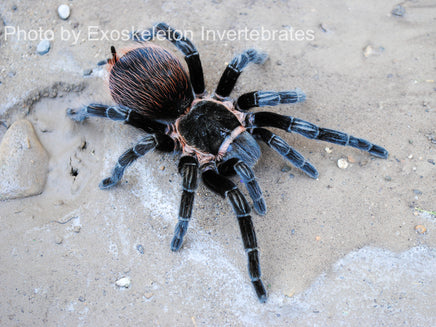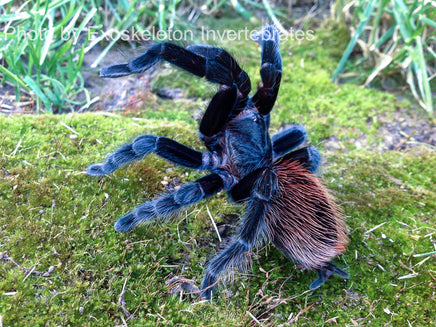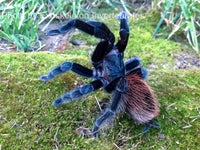Tliltocatl vagans
The Mexican Red Rump
The Tliltocatl vagans, or Mexican Red Rump, is known for its striking dark body with a contrasting fiery red abdomen. This hardy terrestrial species is ideal for beginners due to its resilience and straightforward care requirements. It’s a captivating display tarantula, sure to add vibrancy to any collection.
Care Details:
-
Temperature: 75 to 85°F (24 to 29°C). Tarantulas in warmer environments eat more, grow faster, and molt quicker. This care flexibility makes tarantulas easy to maintain.
-
Humidity: 65-75%. Water dishes are not necessary, but if used, they pose no harm. I personally do not use them.
-
Housing:
- Babies: 1 oz to 4 oz deli container with needle-made ventilation. Free containers available at checkout, but please request one during checkout, or it will not be included.
- Juveniles: Enclosure 2 to 3 times their size with some flexibility.
- Adults: Enclosure twice their size, with enough substrate for occasional burrowing.
-
Diet: I personally give them a variety of crickets and cockroaches, including Dubia, Red-runner, Lobster, and Madagascar hissing roaches. For baby tarantulas, baby crickets and baby roaches are ideal. If you have access to only one type of prey, that is also perfectly fine.
If you cannot find a small enough cricket or cockroach, just crush its head and leave it in the enclosure; your tarantula should handle the rest.
Remember to remove any uneaten food to prevent any mold growth.
And for an occasional treat, a pinky or hopper mouse adds a nice variety to their diet. Make sure to not overfeed rodents and feeder lizards to your tarantulas; these should be done every once in a while as a treat. Too much calcium is not good for the tarantula as it can cause compaction and the tarantula might have a hard time pooping.
In-depth Facts:
- Latin name: Tliltocatl vagans
- Common name: Mexican Red Rump
- Locale: Mexico, Central America, and parts of Florida (introduced populations)
- Category: Terrestrial; moderate webber and frequent burrower.
- Size: Females reach up to 6 inches; males are smaller and more slender.
- Urticating hairs: Yes, possesses urticating hairs.
- Growth rate: Moderate, with steady development.
- Life span: Females live up to 20 years, while males generally live around 5-6 years.
- Recommended level: Suitable for beginners and collectors interested in a striking, easy-to-care-for species.
Stay Connected:
- Instagram: Follow my Instagram, I'm most active here.
- YouTube: For care and education videos, check out my YouTube channel.
- Facebook: Over here I have all my reviews.
- TikTok: Visit my TikTok for additional content.
Safety Disclaimer:
Experiencing a tarantula bite is an extremely rare occurrence, and it's important to note that there have been no recorded fatalities due to a tarantula bite. The venom potency varies across species, with Old World tarantulas generally having stronger venom than their New World counterparts. Within the Old World category, the Poecilotheria genus is known for having particularly potent venom.
It's crucial to approach tarantulas with respect and understanding. If you happen to get bitten, which is unlikely, the key is to stay calm. In most cases, the discomfort is superficial and subsides within a few minutes to a few hours. However, bites from species with more potent venom may result in symptoms lasting up to a week. Remember, larger tarantulas tend to have more venom than smaller ones.
Please be aware that I cannot assume responsibility for bites. Tarantula handling should be done at your own risk. In my 11 years of experience with these creatures, I have only been bitten once, by a species with highly potent venom. While the experience was painful, the symptoms had completely disappeared after a week.
Handle tarantulas responsibly, and always prioritize your safety and the well-being of the tarantula.



